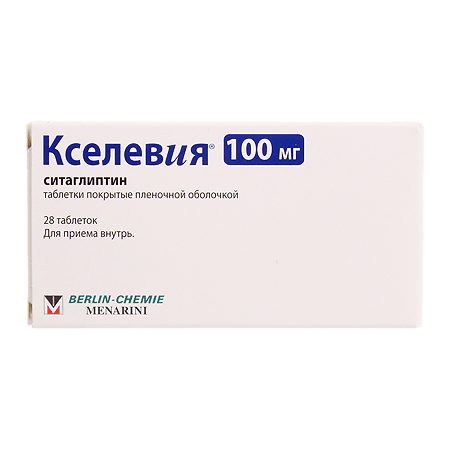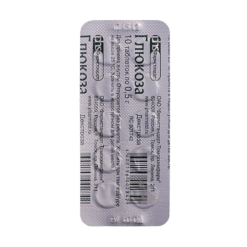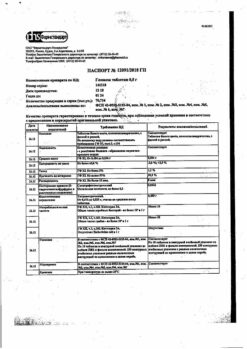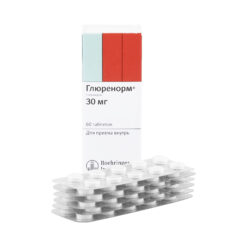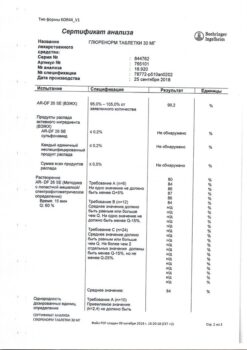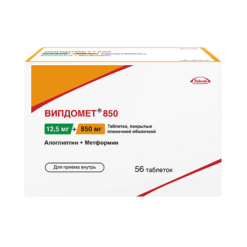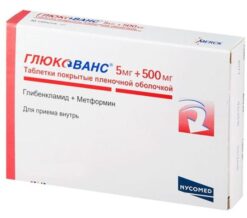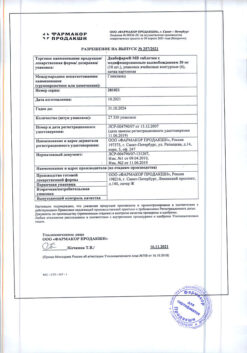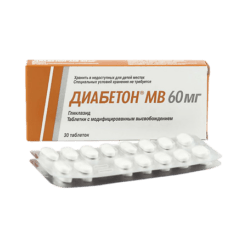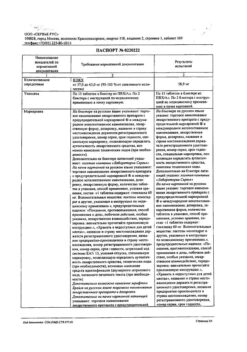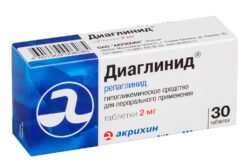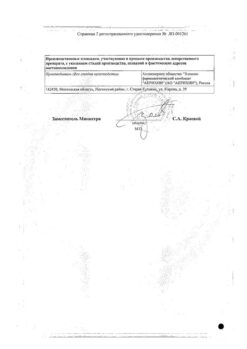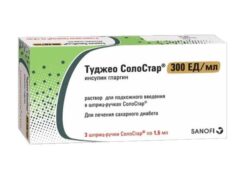No products in the cart.
Xelevia, 100 mg 28 pcs.
€42.15 €35.12
Description
Xelevia® (sitagliptin) is an orally active, highly selective inhibitor of dipeptidyl peptidase-4 (DPP-4) enzyme intended for the treatment of type 2 diabetes.
Indications
Indications
Monotherapy
Xelevia® is indicated as an adjunct to diet and exercise to improve glycemic control in patients with type 2 diabetes mellitus.
Combination therapy
Combination with metformin
Xelevia® in combination with metformin is indicated in patients with type 2 diabetes mellitus to improve glycemic control as initial therapy or when diet and exercise in combination with monotherapy with one of the listed drugs does not lead to adequate glycemic control.
Combination with sulfonylurea derivatives
Xelevia® in combination with sulfonylurea derivatives is indicated for patients with type 2 diabetes mellitus to improve glycemic control when diet and exercise in combination with monotherapy with one of the listed drugs do not lead to adequate glycemic control.
Combination with PPAR-γ agonists
Xelevia® in combination with PPAR-γ agonists (thiazolidinediones) is indicated in patients with type 2 diabetes mellitus to improve glycemic control when diet and exercise in combination with monotherapy with one of these drugs do not lead to adequate glycemic control.
Combination with metformin and sulfonylureas
Xelevia® in combination with metformin and sulfonylureas is indicated in patients with type 2 diabetes mellitus to improve glycemic control when diet and exercise in combination with therapy with two of the listed drugs do not lead to adequate glycemic control.
Combination with metformin and PPAR-γ agonists
Xelevia® in combination with metformin and PPAR-γ agonists (thiazolidinediones) is indicated in patients with type 2 diabetes mellitus to improve glycemic control when diet and exercise in combination with therapy with two of these drugs do not lead to adequate glycemic control.
Combination with insulin
Xelevia® is indicated in patients with type 2 diabetes mellitus as an adjunct to insulin (with or without metformin) in cases where diet, exercise and a stable dose of insulin do not lead to adequate glycemic control.
Pharmacological effect
Pharmacological effect
Xelevia® (sitagliptin) is an orally active, highly selective dipeptidyl peptidase-4 (DPP-4) enzyme inhibitor intended for the treatment of type 2 diabetes mellitus.
Special instructions
Special instructions
Hypoglycemia
According to clinical studies of sitagliptin, the incidence of hypoglycemia during monotherapy or combination therapy with drugs that do not cause hypoglycemia (metformin, pioglitazone) was comparable to the incidence of hypoglycemia in the placebo group. As with other hypoglycemic drugs, hypoglycemia was observed when sitagliptin was used in combination with insulin or sulfonylureas (see section “Side effects”). In order to reduce the risk of developing sulfone-induced hypoglycemia, the dose of the sulfonylurea derivative should be reduced (see section “Dosage and Administration”).
Use in the elderly
In clinical studies, the efficacy and safety of sitagliptin in elderly patients (≥65 years, 409 patients) were comparable to those in patients younger than 65 years. No dose adjustment is required depending on age. Elderly patients are more likely to develop kidney failure. Accordingly, as in other age groups, dose adjustment is necessary in patients with severe renal failure (see section “Dosage and Administration”).
Sitagliptin Cardiovascular Safety Study (TECOS)
In the Study to Evaluate the Cardiovascular Safety of Sitagliptin (TECOS), patients received sitagliptin 100 mg per day (or 50 mg per day if baseline estimated glomerular filtration rate (eGFR) was ≥30 and <50 mL/min/1.73 m2) or placebo added to standard therapy according to existing national standards for setting HbA1C targets and controlling cardiovascular risk factors. After a median follow-up of 3 years, in patients with type 2 diabetes, taking sitagliptin in addition to standard treatment did not increase the risk of serious cardiovascular adverse events (hazard ratio, 0.98; 95% confidence interval, 0.89 to 1.08; P < 0.001 for evidence of non-benefit) or risk of hospitalization due to heart failure (hazard ratio, 1.00; 95% confidence interval, 0.83-1.20; p=0.98 for risk difference) compared with standard treatment without additional sitagliptin.Impact on the ability to drive vehicles. Wed and fur.:
No studies have been conducted to study the effect of Xelevia® on the ability to drive vehicles and operate machinery. However, Xelevia® is not expected to have a negative effect on the ability to drive vehicles or use machinery.
Active ingredient
Active ingredient
Sitagliptin
Composition
Composition
One film-coated tablet contains:
Contraindications
Contraindications
– Hypersensitivity to any of the components of the drug;
– pregnancy, breastfeeding period;
– diabetes mellitus type 1;
– diabetic ketoacidosis;
– children under 18 years of age;
– renal failure of moderate and severe severity (for this dosage – see section “Method of administration and dosage”).
With caution:
Kidney failure
The main route of elimination of sitagliptin from the body is renal excretion. To achieve the same plasma concentrations as in patients with normal renal excretory function, patients with moderate to severe renal failure, as well as patients with end-stage chronic renal failure requiring hemodialysis or peritoneal dialysis, require a dose adjustment (reduction) of Xelevia® (see section “Method of administration and dosage. Patients with renal failure”).
Pancreatitis
There have been reports of acute pancreatitis, including hemorrhagic or necrotizing with and without fatal outcome, in patients taking sitagliptin (see section “Side effects”). Patients should be informed of the characteristic symptoms of acute pancreatitis: persistent, severe abdominal pain. Clinical manifestations of pancreatitis disappeared after discontinuation of sitagliptin. If pancreatitis is suspected, you should stop taking Xelevia® and other potentially dangerous medications.
Side Effects
Side Effects
Sitagliptin is generally well tolerated both in monotherapy and in combination with other hypoglycemic drugs. In clinical studies, the overall incidence of adverse events and the incidence of drug discontinuation due to adverse events were similar to those observed with placebo.
According to 4 placebo-controlled studies (lasting 18-24 weeks) of sitagliptin at a daily dose of 100-200 mg as mono- or combination therapy with metformin or pioglitazone, no study-related adverse reactions were observed, the frequency of which exceeded 1% in the group of patients taking sitagliptin. The safety profile of the 200 mg daily dose was comparable to that of the 100 mg daily dose.
Analysis of data obtained from the above clinical studies showed that the overall incidence of hypoglycemia in patients taking sitagliptin was similar to that when taking placebo (sitagliptin 100 mg – 1.2%, sitagliptin 200 mg – 0.9%, placebo – 0.9%). The frequency of monitored adverse events from the gastrointestinal tract when taking sitagliptin at both doses was similar to that when taking placebo (with the exception of more frequent occurrence of nausea when taking sitagliptin at a dose of 200 mg per day): abdominal pain (sitagliptin 100 mg – 2.3%, sitagliptin 200 mg – 1.3%, placebo – 2.1%), nausea (1.4%, 2.9%, 0.6%), vomiting (0.8%, 0.7%, 0.9%), diarrhea (3.0%, 2.6%, 2.3%).
In all studies, adverse reactions of hypoglycemia were recorded based on all reports of clinically significant symptoms of hypoglycemia; parallel measurement of blood glucose concentration was not required.
Initial combination therapy with metformin
In a 24-week placebo-controlled factorial study of initial combination therapy with sitagliptin at a daily dose of 100 mg and metformin at a daily dose of 1000 mg or 2000 mg (sitagliptin 50 mg + metformin 500 mg or 1000 mg x 2 times a day), the following adverse events were observed in the combination treatment group compared with the metformin monotherapy group phenomena:
drug-related adverse reactions observed with a frequency of ≥1% in the sitagliptin treatment group and more often than in the metformin monotherapy treatment group: diarrhea (sitagliptin + metformin – 3.5%, metformin – 3.3%), dyspepsia (1.3%, 1.1%), headache (1.3%, 1.1%), flatulence (1.3%, 0.5%), hypoglycemia (1.1%, 0.5%), vomiting (1.1%, 0.3%).
Combination with sulfonylureas or sulfonylureas and metformin
In a 24-week placebo-controlled study of combination therapy with sitagliptin (100 mg daily dose) and glimepiride or glimepiride and metformin, the following adverse events were observed in the study drug group compared with the placebo and glimepiride or glimepiride and metformin group:
drug-related adverse reactions observed with a frequency of ≥1% in the sitagliptin treatment group and more often than in the combination therapy group with placebo: hypoglycemia (sitagliptin – 9.5%, placebo – 0.9%).
Initial combination therapy with PPAR-γ agonists
In a 24-week study of initial combination therapy with sitagliptin 100 mg daily and pioglitazone 30 mg daily, the following adverse events were observed in the combination treatment group compared with pioglitazone monotherapy:
drug-related adverse reactions observed with a frequency of ≥1% in the sitagliptin treatment group and more often than in the pioglitazone monotherapy treatment group: asymptomatic decrease in blood glucose concentration (sitagliptin + pioglitazone – 1.1%, pioglitazone – 0.0%), symptomatic hypoglycemia (0.4%, 0.8%).
Combination with PPAR-y agonists and metformin
According to a placebo-controlled study in the treatment of sitagliptin (daily dose 100 mg) in combination with rosiglitazone and metformin, the following adverse events were observed in the study drug group compared with the group of patients taking placebo with rosiglitazone and metformin:
At 18 weeks of observation:
drug-related adverse reactions observed with a frequency of ≥1% in the sitagliptin treatment group and more often than in the combination therapy group with placebo: headache (sitagliptin – 2.4%, placebo – 0.0%), diarrhea (1.8%, 1.1%), nausea (1.2%, 1.1%), hypoglycemia (1.2%, 0.0%), vomiting (1.2%, 0.0%).
At 54 weeks of observation:
Drug-related adverse reactions observed with a frequency of ≥1% in the sitagliptin treatment group and more often than in the combination therapy group with placebo: headache (sitagliptin – 2.4%, placebo – 0.0%), hypoglycemia (2.4%, 0.0%), upper respiratory tract infections (1.8%, 0.0%), nausea (1.2%, 1.1%), cough (1.2%, 0.0%), fungal skin infection (1.2%, 0.0%), peripheral edema (1.2%, 0.0%), vomiting (1.2%, 0.0%).
Combination with insulin
In a 24-week placebo-controlled study of combination therapy with sitagliptin (at a daily dose of 100 mg) and constant-dose insulin (with or without metformin), the following adverse events were observed in the study drug group compared with the placebo and insulin group (with or without metformin):
drug-related adverse reactions observed with a frequency of ≥1% in the sitagliptin treatment group and more often than in the insulin treatment group (with or without metformin): hypoglycemia (sitagliptin + insulin (with or without metformin) – 9.6%, placebo + insulin (with or without metformin) – 5.3%), influenza (1.2%, 0.3%), headache (1.2%, 0.0%).
In another 24-week study in which patients received sitagliptin as adjunctive therapy to insulin therapy (with or without metformin), there were no drug-related adverse reactions reported with an incidence of >1% in the sitagliptin 100 mg group and no incidence in the placebo group.
Pancreatitis
In a pooled analysis of 19 double-blind randomized clinical trials of sitagliptin at a daily dose of 100 mg or a corresponding control drug (active or placebo), the incidence of unconfirmed acute pancreatitis was 0.1 cases per 100 patient-years of treatment in each group (see the section “Precautions. Pancreatitis”, as well as the “Study to evaluate the cardiovascular safety of sitagliptin (TECOS)” below).
No clinically significant abnormalities in vital signs or ECG (including QTc interval) were observed during treatment with sitagliptin.
Sitagliptin Cardiovascular Safety Study (TECOS)
The Study to Evaluate the Cardiovascular Safety of Sitagliptin (TECOS) included 7332 patients who received sitagliptin 100 mg per day (or 50 mg per day if the baseline estimated glomerular filtration rate (eGFR) was ≥30 and <50 mL/min/1.73 m ) and 7339 patients who received placebo in the general population of patients who were assigned to treatment. The study drug (sitagliptin or placebo) was added to standard therapy according to existing national standards for selecting target HbA1C levels and controlling cardiovascular risk factors. The study included a total of 2004 patients aged 75 years or older (970 receiving sitagliptin and 1034 receiving placebo). The overall incidence of serious adverse events in patients taking sitagliptin was the same as in patients taking placebo. An assessment of previously identified complications associated with diabetes mellitus revealed comparable rates of adverse events between groups, including infections (18.4% in patients treated with sitagliptin and 17.7% in patients treated with placebo) and renal dysfunction (1.4% in patients treated with sitagliptin and 1.5% in patients treated with placebo). The adverse event profile in patients aged 75 years and older was generally similar to that of the general population.
In the intention-to-treat population, among those initially receiving insulin and/or sulfonylureas, the incidence of severe hypoglycemia was 2.7% in patients receiving sitagliptin and 2.5% in patients receiving placebo. Among patients not initially receiving insulin and/or sulfonylureas, the incidence of episodes of severe hypoglycemia was 1.0% in patients taking sitagliptin and 0.7% in patients taking placebo. The incidence of expertly confirmed pancreatitis was 0.3% in patients treated with sitagliptin and 0.2% in patients treated with placebo. The incidence of evidence-based malignancies was 3.7% in patients treated with sitagliptin and 4.0% in patients treated with placebo.
Post-registration observations
During post-marketing monitoring of the use of sitagliptin in monotherapy and/or in combination therapy with other hypoglycemic agents, additional adverse events were identified. Because these data were collected voluntarily from a population of undetermined size, the frequency and causal relationship to treatment of these adverse events cannot be determined. These include:
hypersensitivity reactions, including anaphylaxis, angioedema, rash, urticaria, cutaneous vasculitis, exfoliative skin diseases, including Stevens-Johnson syndrome; acute pancreatitis, including hemorrhagic and necrotizing forms with lethal and non-lethal outcomes; deterioration of kidney function, including acute renal failure (sometimes requiring dialysis); upper respiratory tract infections; nasopharyngitis; constipation; vomit; headache; arthralgia; myalgia; pain in the limb; back pain; itching; pemphigoid.
Changes in laboratory parameters
The incidence of laboratory abnormalities in the sitagliptin treatment groups (at a daily dose of 100 mg) was comparable to that in the placebo groups. In most, but not all clinical studies, there was a small increase in white blood cell count (approximately 200/μL compared with placebo, mean at baseline 6600/μL) due to an increase in neutrophil counts.
Analysis of data from clinical trials of the drug showed a slight increase in uric acid concentrations (approximately 0.2 mg/dL compared to placebo, average concentration before treatment 5-5.5 mg/dL) in patients receiving sitagliptin at doses of 100 and 200 mg per day. No cases of gout were reported. A small decrease in total alkaline phosphatase concentrations was observed (approximately 5 IU/L compared with placebo, mean pre-treatment concentration 56-62 IU/L), partly due to a small decrease in bone alkaline phosphatase fraction.
The listed changes in laboratory parameters are not considered clinically significant.
Interaction
Interaction
In drug interaction studies, sitagliptin did not have a clinically significant effect on the pharmacokinetics of the following drugs: metformin, rosiglitazone, glibenclamide, simvastatin, warfarin, oral contraceptives. Based on these data, sitagliptin does not inhibit CYP3A4, 2C8 or 2C9. Based on in vitro data, sitagliptin also does not inhibit the isoenzymes CYP2D6, 1A2, 2C19 and 2B6 and does not induce the CYP3A4 isoenzyme.
Overdose
Overdose
During clinical studies in healthy volunteers, a single dose of 800 mg sitagliptin was generally well tolerated. Minimal changes in the QTc interval, not considered clinically significant, were observed in one study of sitagliptin at a dose of 800 mg per day. Doses above 800 mg per day have not been studied in humans.
In phase I clinical studies of repeated dosing, no adverse reactions associated with sitagliptin treatment were observed when taking the drug in a daily dose of up to 400 mg for 28 days.
In case of overdose, standard supportive measures should be initiated: removal of unabsorbed drug from the gastrointestinal tract, monitoring vital signs, including ECG, and prescribing supportive care if required.
Sitagliptin is poorly dialyzable. In clinical studies, only 13.5% of the dose was removed from the body during a 3-4 hour dialysis session. Long-term dialysis may be prescribed if clinically necessary. There are no data on the effectiveness of peritoneal dialysis with sitagliptin.
Storage conditions
Storage conditions
Store at a temperature not exceeding 25 °C.
Shelf life
Shelf life
2 years.
Manufacturer
Manufacturer
Berlin-Pharma, Russia
Additional information
| Shelf life | 2 years. |
|---|---|
| Conditions of storage | Store at a temperature not exceeding 25 ° C. |
| Manufacturer | Berlin-Pharma, Russia |
| Medication form | pills |
| Brand | Berlin-Pharma |
Related products
Buy Xelevia, 100 mg 28 pcs. with delivery to USA, UK, Europe and over 120 other countries.

